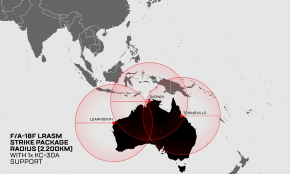Well then we should have selected ships before now.Of course you try to match threat and response but that sometimes does not go at all well - just ask Repulse or PoW. We in uniform accept that, it’s part of the deal, but we sure don’t want to make it a likely situation, where some genius decides that yes, an OPV90 because it has a pop gun and a couple of cells (but probably insufficient DC) is capable of doing a task that blind Freddy knows it can’t. The ship is the best lifebelt, and we need to give combatants of any size the best chance of staying afloat while not compromising the ability to achieve their missions.
We are building the Arafura and the Hunter. That is it and the Hunter looks like joining the RAN FOC sometime in the late 2020's.
I guess I am trying to be realistic.
- We lose one Anzac permanently. Possibly more.
- We lose all three Hobarts with MLU 2024- ~2030s. Navantia on track for Hobart Class modernisation milestones
- We lose all six Collins with LOTE till 2024~2030s. Collins Life of Type Extension - ASC
- We lose the remaining 7 Anzacs with their upgrades around 2024-2030. Not all at once but like the previous Anzac upgrade, certainly reduced capability during this period. 2024~2030s https://www.anao.gov.au/work/performance-audit/anzac-class-frigates-sustainment. https://www.australiandefence.com.au/defence/sea/anzac-frigates-to-gain-capability-lose-weight It should be noted that we are currently operating them with nearly 200 crew and for longer periods, despite the fact they are old ships, while upgraded, mostly still have old hotel services and systems at the core of the ship. This costs money. $3.4b between 2019-2027.
Why build OPV80's at all, why not build OPV50's? Why build anything, perhaps we can life extend Armidale's, $3b for another 10 years, and during that 10 years most won't be available for the upgrade. Leave the original golden rivet and rebuild the entire ship around it, complete with circa 1990's tech. Are the broken 300t 20 year old aluminium Armidales more survivable than a 90m 2500t steel OPV's? Last time we were doing deep maintenance on the Patrol boats we lost one in a fire.
What are we hitting in our region with more than 24 of our 220 Tomahawks? Whats the defended target you are concerned about?Let us just say then that I have a rather different perspective on how effective Tomahawk LACM's would be, if Australia attempted to use them as some seem to be suggesting.
One needs to remember that if a target is worth Australia taking warshots at, then said target is also likely worth being defended by whoever Australia would be shooting at. This means that enough ordnance would need to arrive on target, through whatever potential and likely defences might be trying to intercept the inbound LACM. This is also assuming that Australia can get the targeting data it would need in order to make attempting the strike worthwhile.
At this point, I remain skeptical that even a strike package of 24 Tomahawks would be worthwhile.
From ADBR.. I think Australia has a reasonable strike capability. China effectively has no presence in our region with hardened targets. So unless we are striking against US targets?

